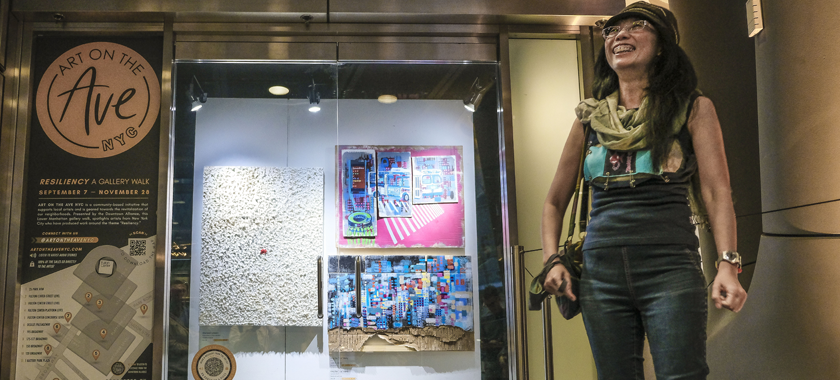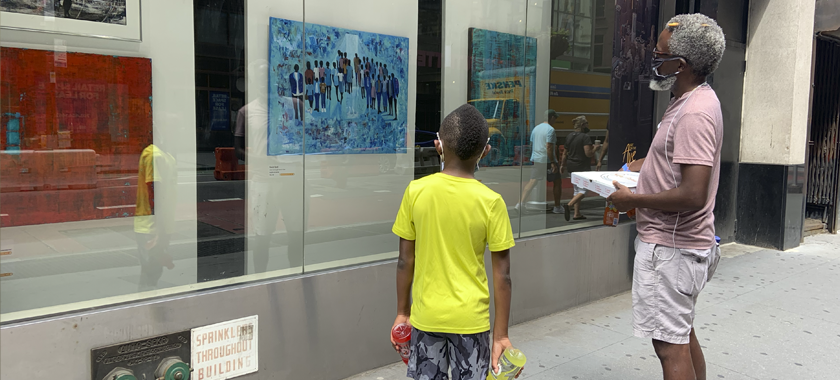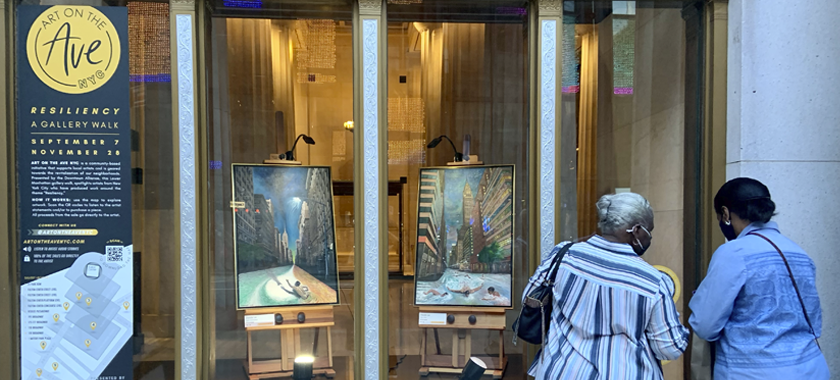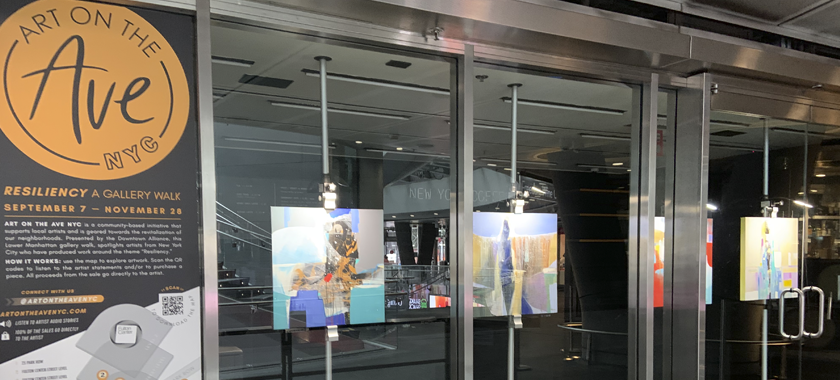
Conversations | Art on the Avenue
How this Fiscally Sponsored project utilizes public art to encourage community and spur conversation.
Art on the Avenue (Art on the Ave) activates the streetscape by turning vacant storefronts into street-facing galleries displaying work by underrepresented voices. The project, which is Fiscally Sponsored by NYFA, was conceived in June 2020 by teachers Barbara Anderson and Jackie Graham.
Anderson and Graham were looking for a way to discuss the year’s events—the trauma and tragedy, heroism and hope—with students and provide a platform for people to process the complex emotions of the pandemic. In addition, they recognized the unfortunate closure of many small neighborhood businesses.
Together, they made Art on the Avenue a reality, bringing evocative art to empty shop windows and turning streets into gallery spaces that encourage reflection and spark conversation. We spoke with Anderson to learn more about the project and the importance of building community.

NYFA: What does it mean to be a creator/organizer who is working with the community?
Barbara Anderson: Being an organizer working with the community means having to consider many different angles and perspectives. Art on the Ave is as heavy on the “ave” as it is on the “art.” Our organization has to consider the overall benefit to the neighborhood and community.
One of the things we have heard repeatedly from people in the communities who have purchased art is that they fell in love with the piece gradually. First, they gave it a glance. Another time, they stopped to have a closer look. Then they stopped and listened to the audio story and the artist’s voice and finally they brought a friend along to see it. Then it felt like it belonged to them. This only happens when an exhibition is in place long enough.
Art on the Ave makes it a point to engage with neighboring businesses—perhaps convincing them to have a logo, host the gallery walk maps, or even, make space for a piece of art. So, the residents matter. The smaller businesses matter. And of course, the property owners matter. We have to ensure that the stores look great, that there is still access, that people can see the property, and that rental signage is visible. Art on the Ave is not just an art exhibition. It is a community initiative at its core.
Art on the Ave is not just an art exhibition. It is a community initiative at its core.
-Barbara Anderson
NYFA: Your work organizing Art on the Ave is important for creating an arts ecosystem because it provides exhibition opportunities for artists. How do you go about connecting with the artists that you want to participate in your programs?
BA: Initially, we relied solely on a few local publications sharing our call to art. We did not have a following of our own. We hire different curators for each exhibition because this is another way for us to expand the reach of our calls to art.
Jackie and I also spend a lot of time checking out people’s websites, Instagrams, etc and reaching out to artists we think might benefit from more exposure. We write and send the call to arts organizations around the city as well and go onto Arts Council websites from the outer boroughs to share the calls personally. Artists also share our calls now and help us spread the word.
It still never fails that as soon as we launch an exhibition, artists from the area write to say “but we didn’t know…” We are always sorry about that, but luckily we have so far been able to tell them to apply for the next one! We always keep track of these people and Jackie writes to them personally.

NYFA: How have you built your audience over time? How has your audience changed/grown over time?
BA: Jackie does a great job of promoting our artists, participating businesses, and property owners on social media. I am always connecting with different groups or trying to. I organize walks for school groups, for ex-pat groups, for other artists, and for community organizations. I never feel like I reach enough people, but the word gets around and we find that people are more familiar with the name now.
We try hard to bring our exhibitions attention through traditional media channels as well. This is becoming more difficult as the story has been told. But each exhibition is different and there is always a different angle a story can take. Therefore, I find myself not only reaching out but often creating a new narrative—one that suits the neighborhood we are in.
NYFA: What role do grants play in your fundraising?
BA: This is a bit of a sore point for us and a frustration. We have had no grants at all. We are a small team trying to do a lot and we spend all of our time putting exhibitions together. We have had three in a year and are about to launch a fourth.
We don’t seem to fit into many of the categories for grants to begin with, and we are not a formal enough organization. We have not formed a board and we keep things small and simple. It has worked for us and we are proud of what we’ve done, but we do not or have not had the bandwidth to create the kind of organization that will satisfy those who give out grants.
It is a catch 22. Without the grants, we can’t afford salaries, and without paying someone to help us, we can’t spend the time applying for grants, forming the board etc…

NYFA: Barbara, you and your collaborator joined NYFA Fiscal Sponsorship as experienced teachers, and newbies in the nonprofit sector. Your team had a vision of wanting to see something in your neighborhood. What is it like entering this space without much experience? What do you know now that you didn’t in the beginning? Do you have any suggestions for other arts enthusiasts who are interested in creating opportunities for artists?
BA: You are right. We are teachers who are not necessarily experienced in the art world of New York. But, as teachers, we know a lot more about putting together projects with various stakeholders than other people do. We always deal with reluctant learners—in this case many of the property owners. We are well versed in making things happen with no budget. We are used to making people play nicely.
I do not mean to sound condescending, but in a lot of ways, this was just a bigger version of a school project. We knew the end game. We had a vision of what it could be. We had to sell a weird idea to a bunch of people who didn’t necessarily have to listen. That is teaching too! The obstacles were part and parcel. The more of them came up, the more we met people who helped us refine the idea or helped us find the “workaround.” In the end, Art on the Ave does not have a lot of downsides.
There are too many things we know now that we didn’t know then to even go into that. From creating artist contracts, to getting insurance and forming an LLC, to understanding how to find property owners and how to get them to listen. With every exhibition we continue to make mistakes but with each one, we learn more and do better.
With every exhibition we continue to make mistakes but with each one, we learn more and do better.
-Barbara Anderson
My suggestion to others is to just go for it! It sounds so simple but if we had tried to solve each problem first and then launched the project, we’d still be at the planning stage of the first one. Just go all in and give it a try. Even if we had just got one store to agree, it would have been better than nothing.
NYFA: How has working with a fiscal sponsor built your work and when did you decide that you needed/wanted a sponsor for this project?
BA: We decided we needed a fiscal sponsor pretty much immediately because we were not going to get any donations—at least any big donations—without it. There was no way we had time to form our own 501(c)(3) so this was the way to go.
Working with a fiscal sponsor was a lifesaver for us. Firstly, they answered so many of my questions. I had no idea how to do the accounting, how to pay vendors, or how to do any of the paperwork I needed to do. Madeleine (on the NYFA Fiscal Sponsorship team) has answered countless emails, sat on many Zooms, and basically held my hand most of the way. Jackie and I are very grateful to NYFA for the support we have received and continue to receive.
– Interview conducted by Alicia Ehni, Program Officer, Fiscal Sponsorship
NYFA Fiscal Sponsorship’s quarterly no-fee application deadlines are June 30, September 30, December 31, and March 31. We also accept Out-of-Cycle Review applications year-round. Reach out to us at [email protected] for more information. Sign up for NYFA’s free bi-weekly newsletter to receive updates on future programs.